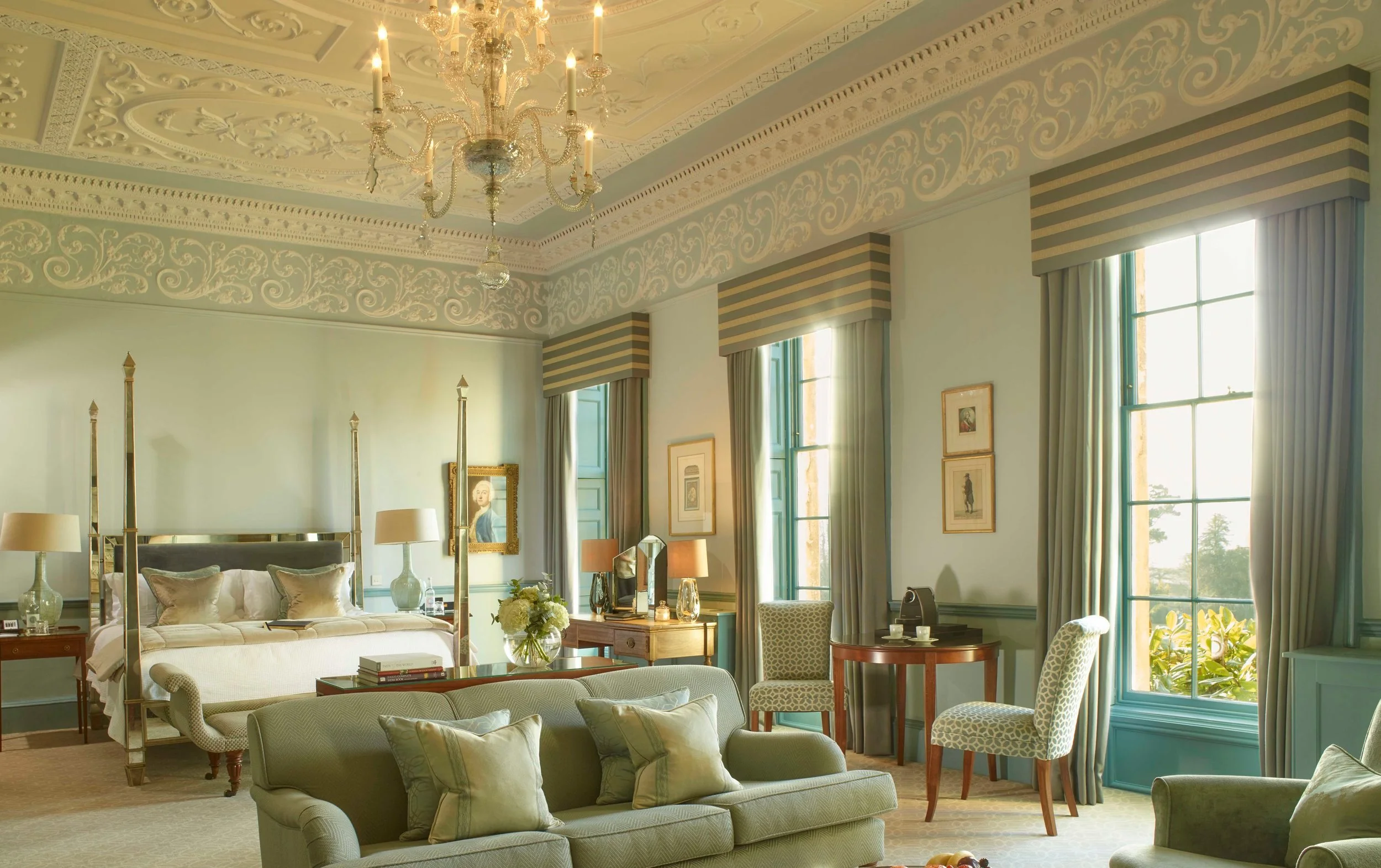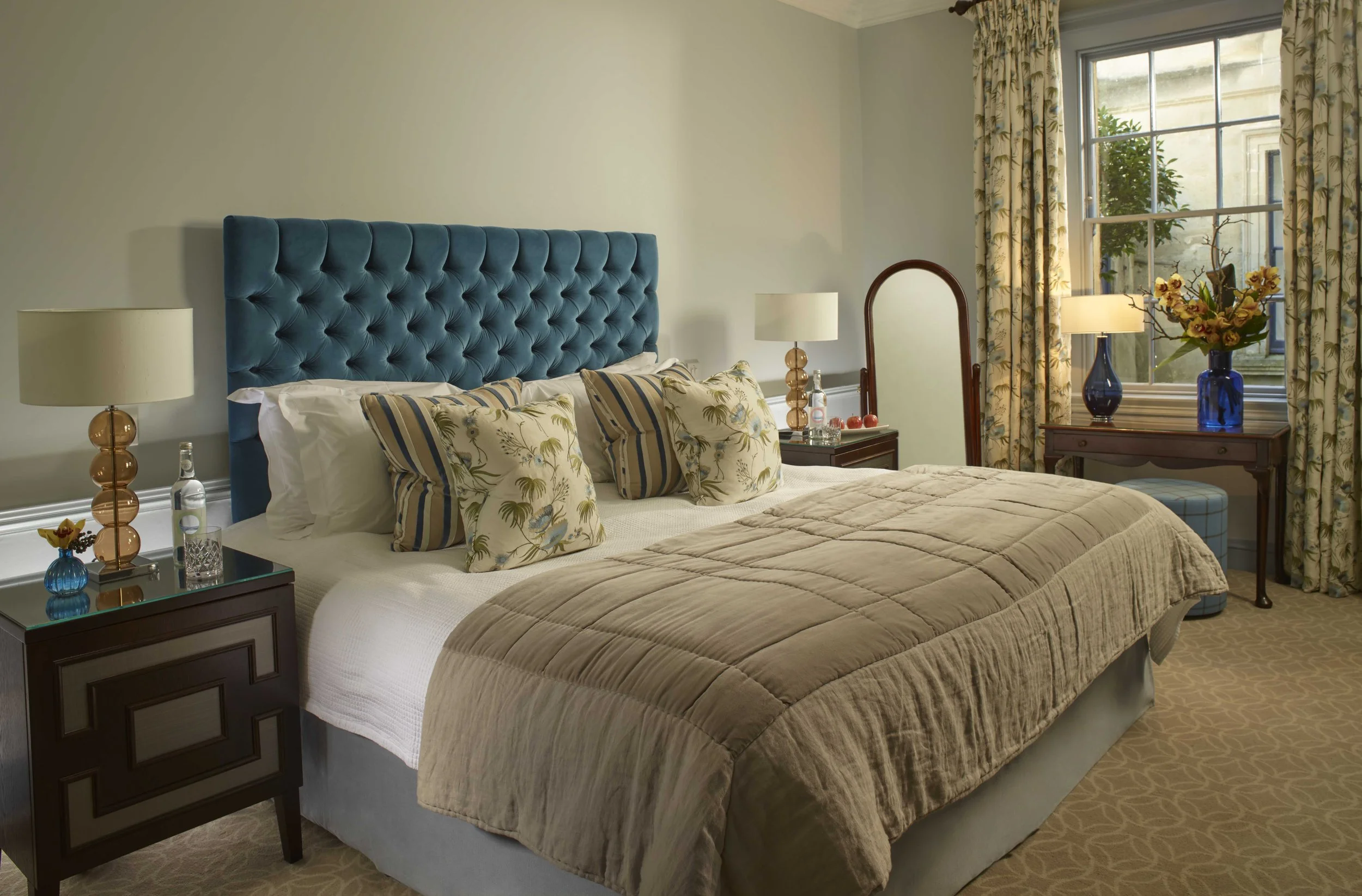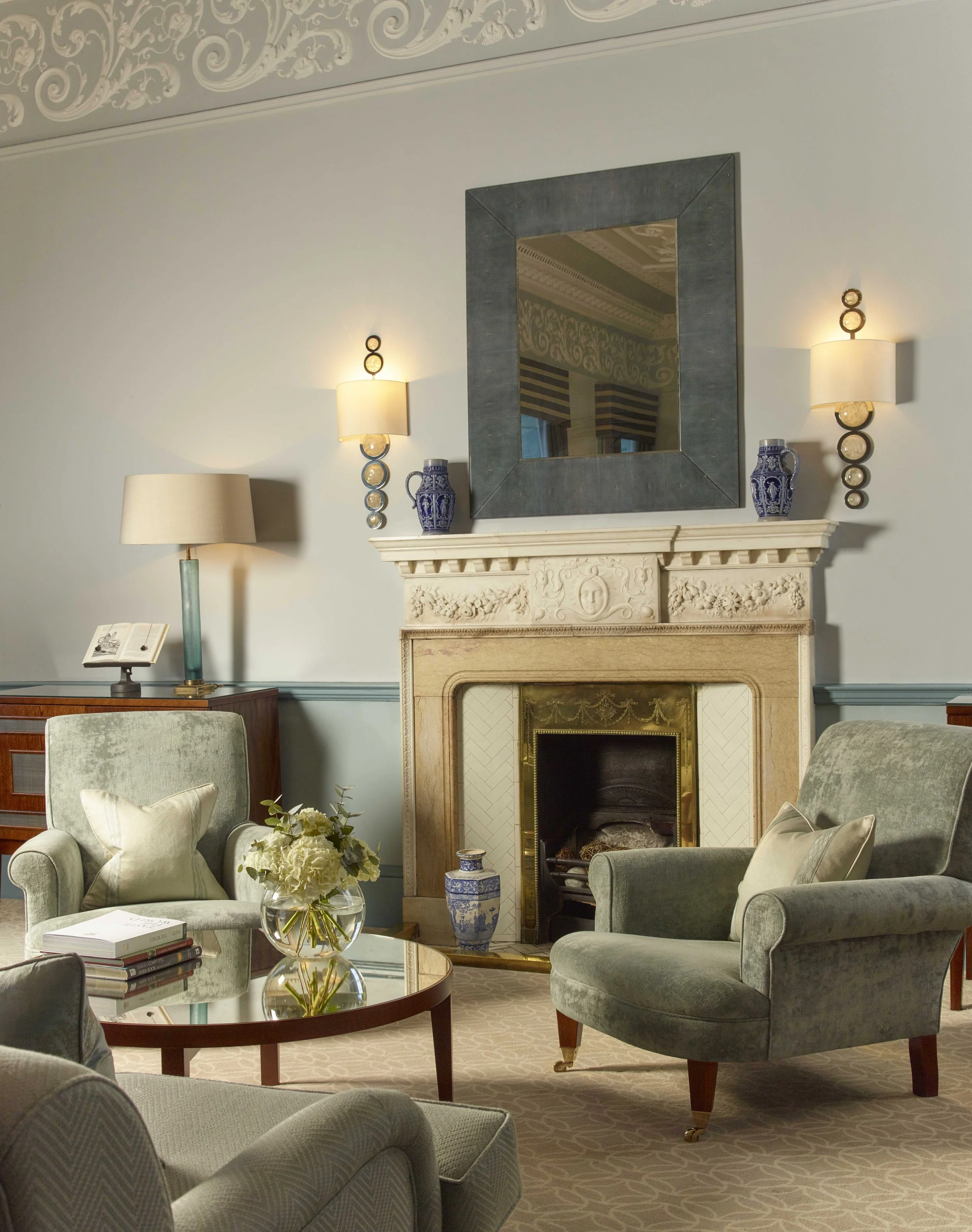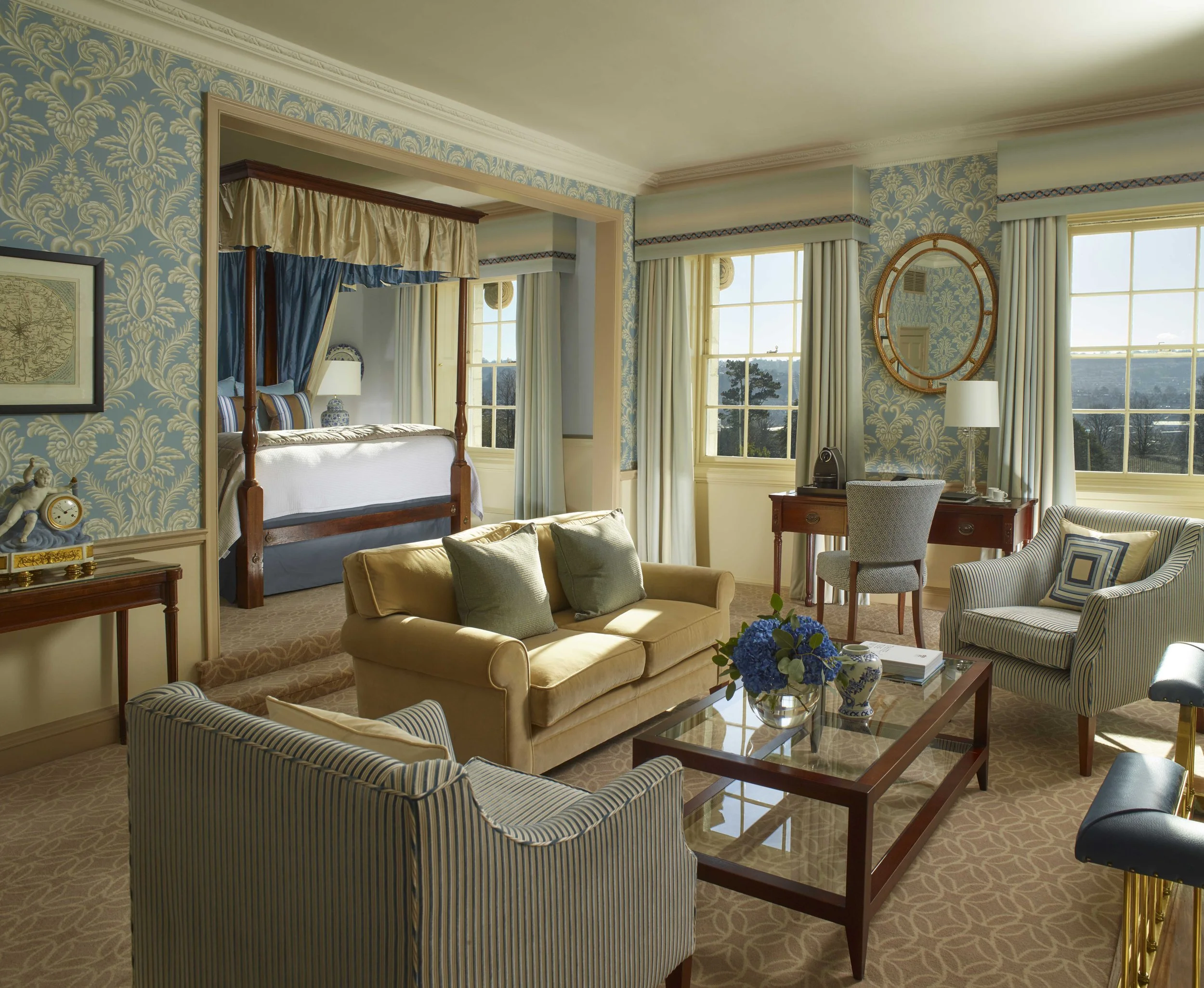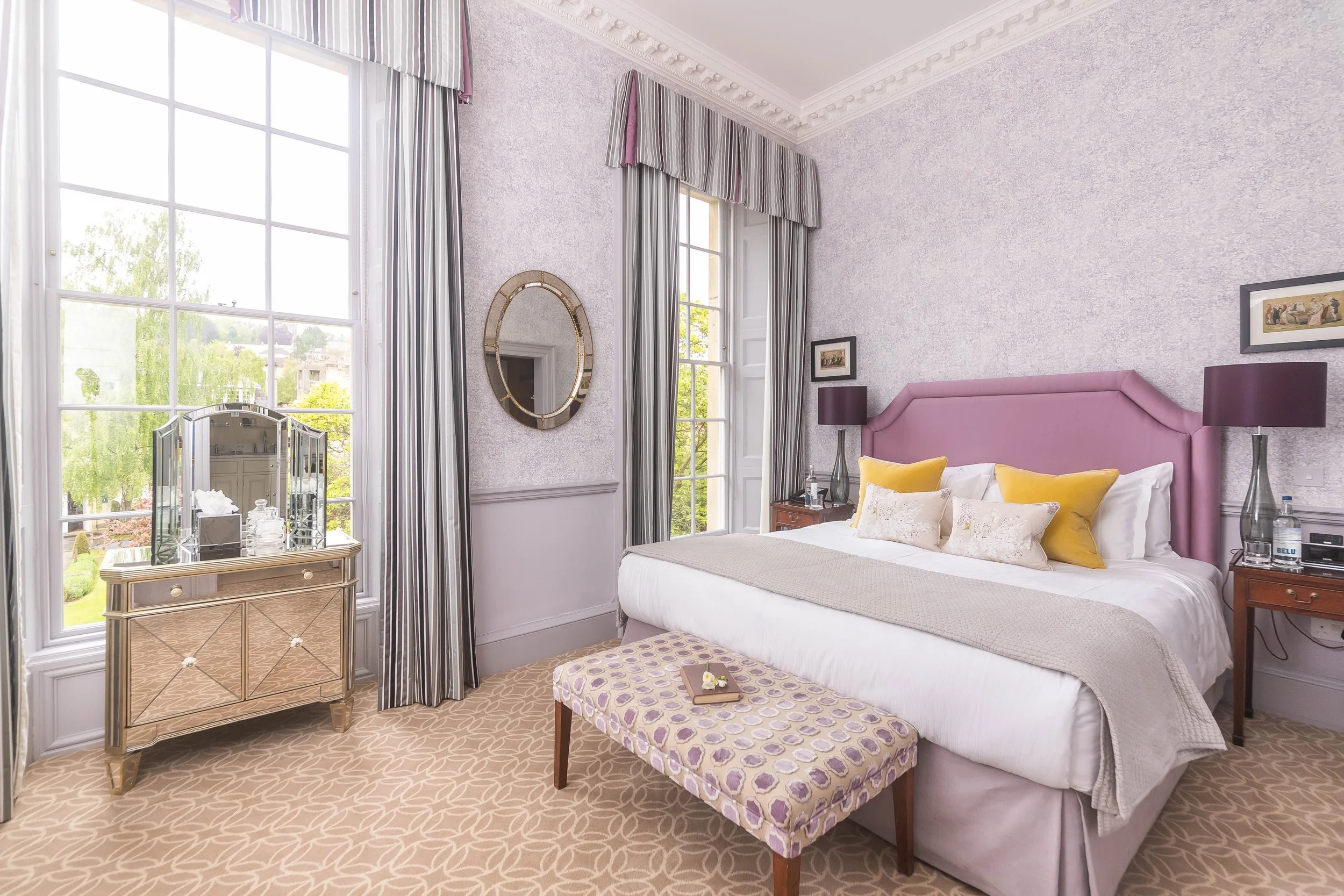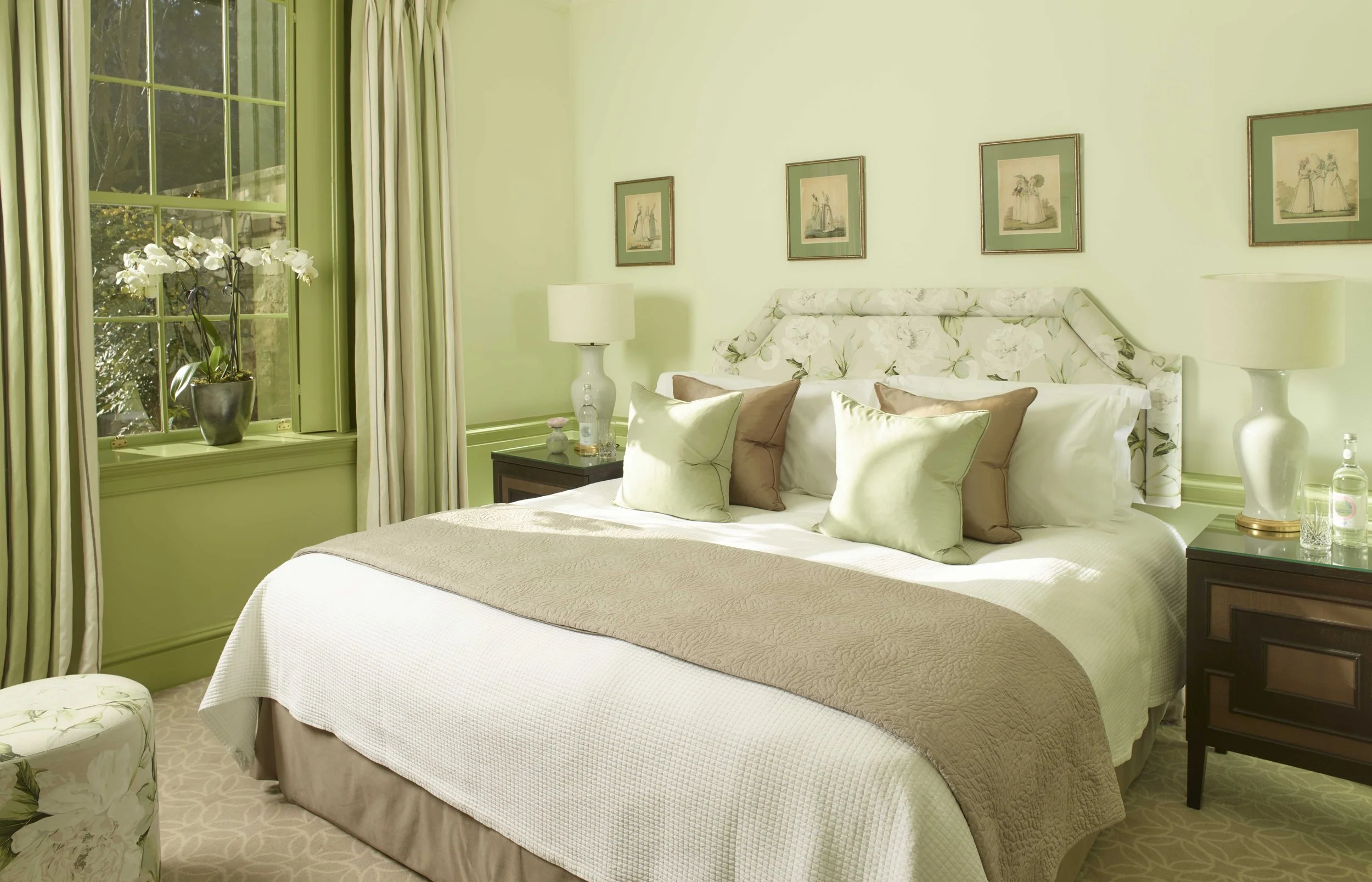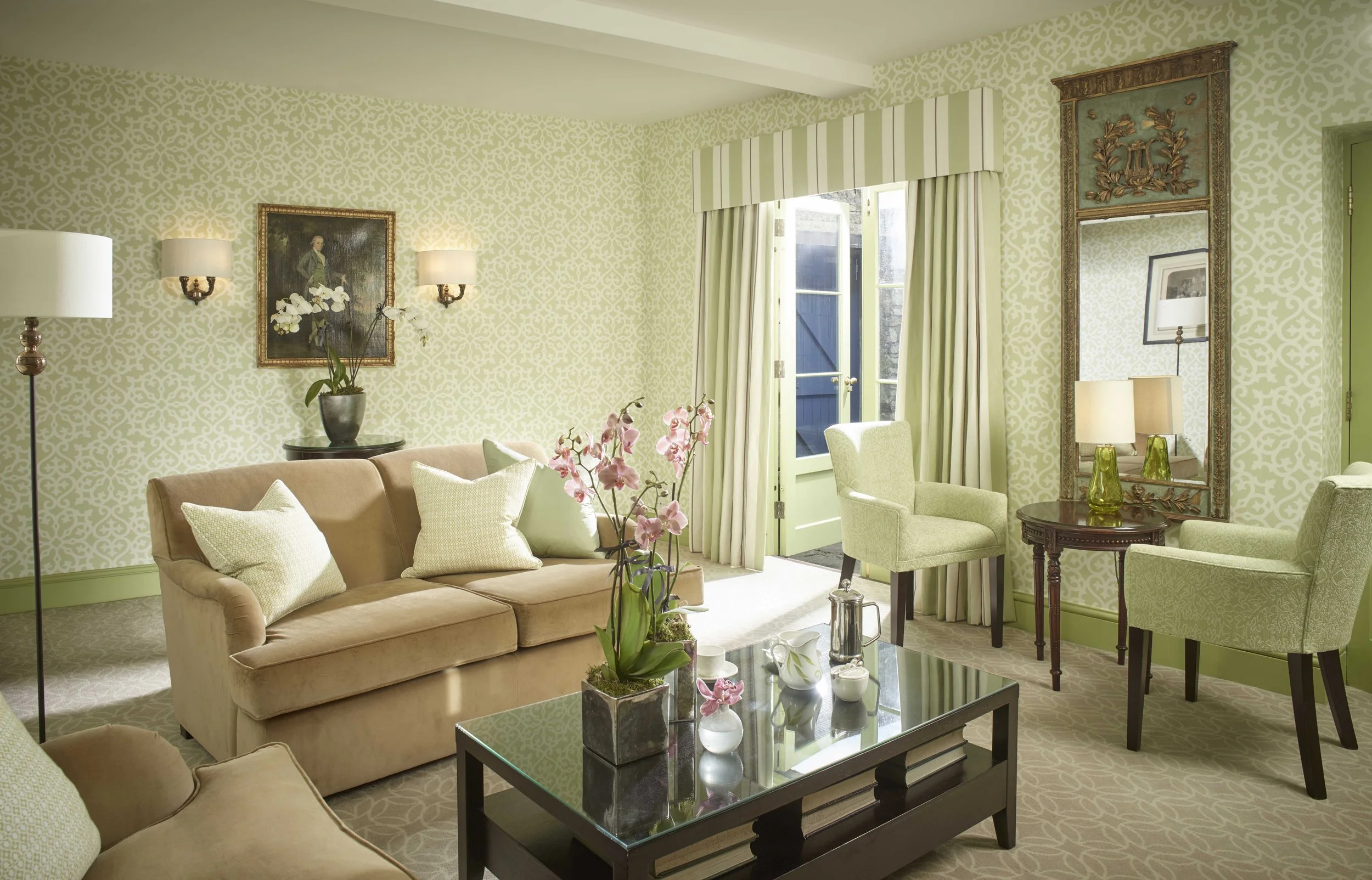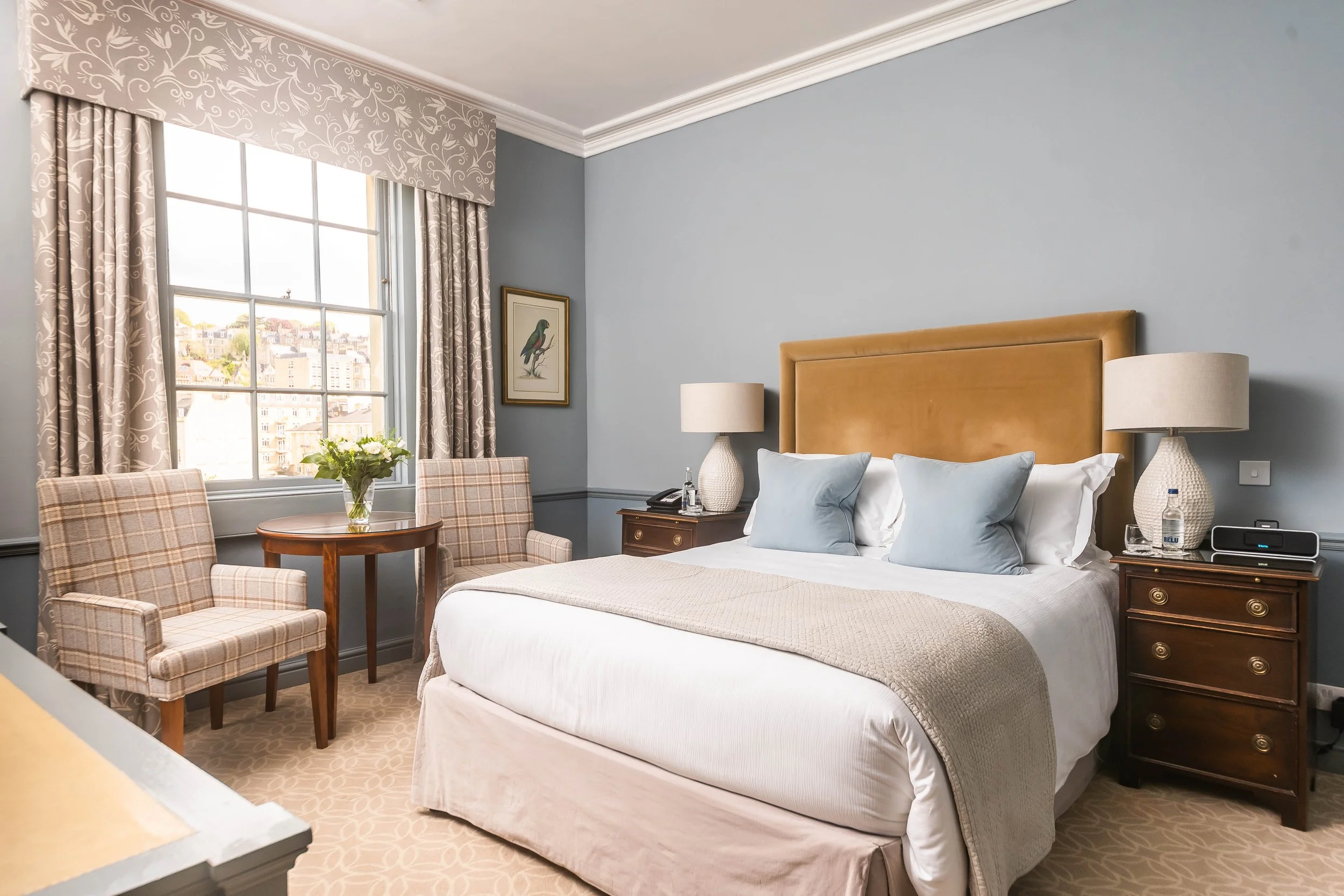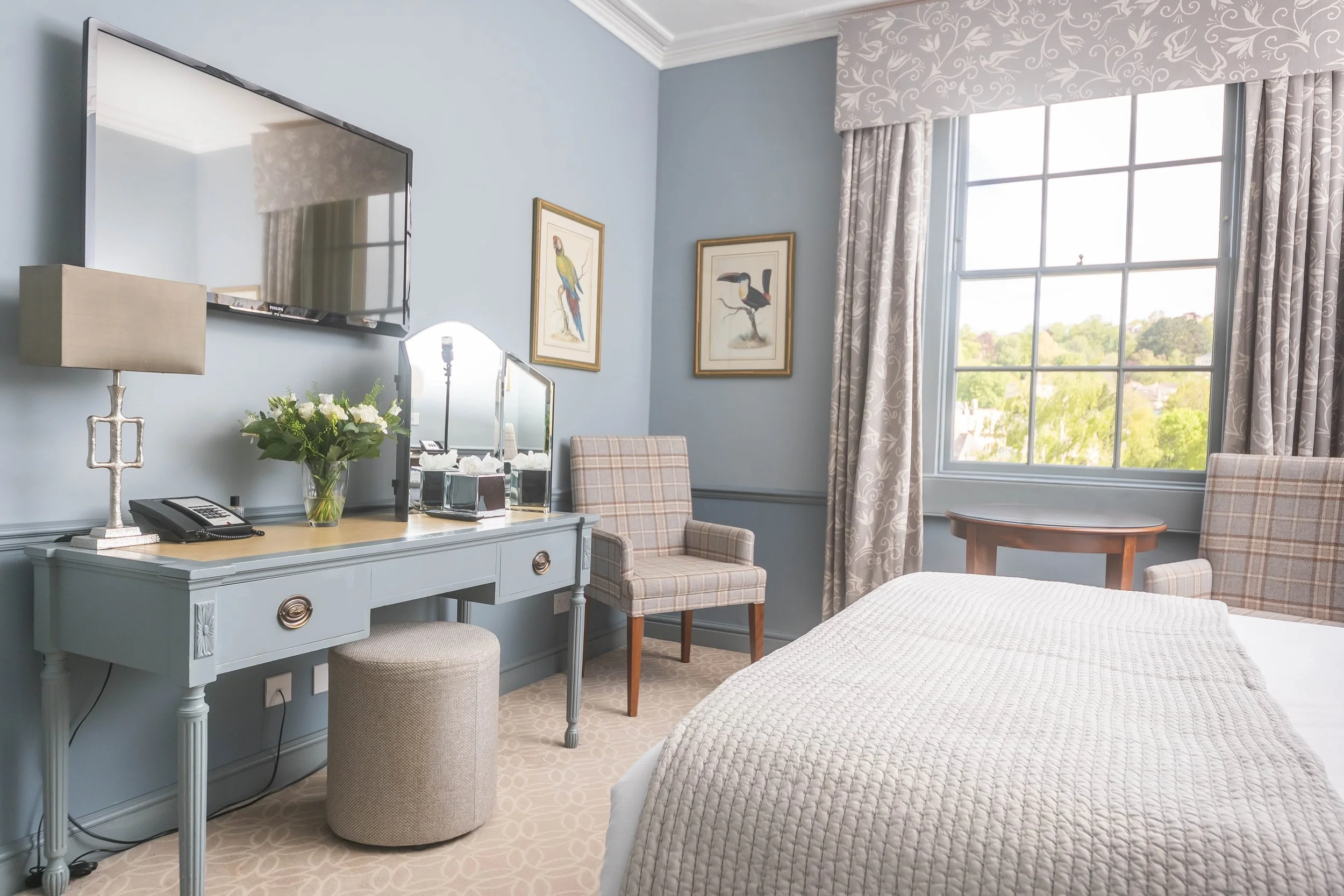Series 2 : THE ROYAL CRESCENT - HISTORIC HOTEL
The Duke Of York Suite
WOOLF Interior Design & Interior Architecture have years of expertise, sensitively designing every aspect of residential and commercial interiors for traditional and historic buildings, in the UK and internationally. We are acknowledged for our specialist skills designing for Grade I or II Listed buildings, including Georgian homes, and are accredited historic interior designers.
The one and original ‘Crescent’ is the outstanding architectural achievement of eighteenth-century Bath. The leisured classes of England, and Europe too have always migrated to Bath, for a ‘health giving’ way of life. The WOOLF Interior Design Bath Studio is located in the crescent above the world famous ‘Royal Crescent Hotel’, our specialism is a focus on historic interiors of the Georgian and Regency houses and hotels. Since its completion in 1775, the Royal Crescent has been enthralling its distinguished visitors and has been attracting attention for its historic interiors and Regency architecture.
At the Royal Crescent Hotel, every bedroom suite has a completely unique interior design and interior décor. Combining modern elegance with traditional character and charm and spectacular Regency scenery from every window. The bedrooms are a glimpse into that historic heyday, with its illustrious, colourful and often entangled clientele and evident French influences. The grandest address in Bath was frequented by several memorable individuals: Artists, actors, authors, architects, astronomers and others, whose accomplishments, ordeals and intrigues are commemorated in the names of the hotel’s 18 suites.
The Nash Suite
The Nash Suite
BEAU NASH SUITE
The interior design of the Richard ‘Beau’ Nash Suite is based upon his life as a career dilettante, who had failed as barrister and army officer, when he stumbled upon his metier in the course of a visit to Bath in 1705. The city, in the foremost flush of fashionability, was made for this hardened gambler and salon habitué who soon established himself as fixer par excellence in Bath’s blossoming social scene. Nash had a knack for navigating a perilous Georgian course between scandalous and stuffy. He quickly became the city’s undisputed master of ceremonies. Nobody takes greater credit, for Bath’s Georgian heyday, without the glamour Nash brought to the city of Bath.
The Duke Of York Suite
The Duke Of York Suite
DUKE OF YORK SUITE
Among the most famous residents of these historic interior designed rooms was the Prince Frederick Suite, Duke of York, favourite son of King George III. Frederick visited Bath in 1795, when he attended the opening of the baths’ new Pump Room and received the Freedom of the City. The city, and no doubt the bestowal of that rare honour, so pleased the Duke and Duchess that they returned the following year to buy the Crescent’s so-called ‘centre house’, apparently for £5,000, an enormous sum at the time.
SIR PERCY BLAKENEY SUITE
SIR PERCY BLAKENEY SUITE
SIR PERCY BLAKENEY SUITE
The Interior decoration of The sir Percy Blakeny suite coveys hints of French interiors. French aristocrats escaping the guillotine, were a common sight in Georgian Bath; some visited during the Revolution in search of Pimpernels. Sir Percy Blakeney lead a double life: outwardly nothing more than a wealthy fop, but in reality a formidable swordsman and a quick-thinking master of disguise and escape artist. A chivalrous Englishman who rescues French aristocrats before they are sent to the guillotine. He is known by his symbol, a simple flower, the scarlet pimpernel where the Pimpernel mention Blakeney living in the Royal crescent.
ELIZABETH LINLEY SUITE
ELIZABETH LINLEY SUITE
ELIZABETH LINLEY SUITE
In the Royal Crescent’s earliest years, on the evening of 18th March 1772, a young woman slipped out of the door of No 11 and boarded the sedan chair which awaited her there. So began one of the most celebrated romantic escapades of the age. Elizabeth Linley was a renowned beauty and soprano who had been enchanting Bath audiences since she was nine. But Elizabeth, now eighteen, had tired of the effects of her own magnetism. She had attracted so many unwanted marriage suits, she resolved to leave it all behind by fleeing to France. The Elizabeth Linley bedroom suite is decorated to convey the romanticism of her life.
JANE AUSTEN SUITE
The Jane Austen interior design of her Bedroom Suite commemorates many great writers, among them Charles Dickens, Tobias Smollett and Henry Fielding, frequented Bath and wrote of it in their novels. But none is so closely associated with the city, as Jane Austen and the Jane Austen suite.
Jane was in her twenties when she first visited Bath. She returned in 1801 when her parson father decided to move the family here on his retirement. Bath did not agree with Jane. She disliked the city’s fraught social demands and superficialities which she was to inflict upon Catherine Morland, heroine of her first novel Northanger Abbey, who undergoes ‘all the difficulties and dangers of a six-week residence in Bath’.
JOHN WOOD SUITE
JOHN WOOD SUITE
The John Wood is a significantly important delux bedroom interior. ‘Wood’ the name of two prominent Bathonians, father and son, whose shared legacy is the astonishingly influential architecture of the city’s Eighteenth-century revival.
John Wood the Elder (1704-54) drew his inspiration not solely from classical Palladianism but was also influenced by a pre-Roman Britannic paganism; a walk round the nearby Circus, completed in 1768 after John Wood the Elder’s death but to his design by John Wood the Younger (1728-82), reveals an exquisitely detailed frieze carved with often druidic and Masonic signs and symbols. The stone circles at Stonehenge and Stanton Drew were as much the inspiration for the Circus as the Roman Colosseum.
John Wood the Younger, who did not share his father’s fascination with sun temples, pursued a plainer neo-classicism; among his achievements were the Hot Bath and the Assembly Rooms, but his masterpiece is the Royal Crescent which he completed in 1775.
RALPH ALLEN SUITE
The Ralph Allen suite is also a key deluxe bedroom suite interior that commemorates an influential historical figure in Bath. In 1726 Allen expanded his architectural interests when he began buying up the local stone quarries at Combe Down. Masons know Bath stone, formed from calcified shell fragments, as ‘freestone’ since it can be cut in any direction. Before the eighteenth century, however, the local stone had largely been used as an undressed rubble. But with Bath entering a period of frenzied neo-classical development, the savvy Allen, a former post delivery boy, recognised that this was to undervalue a stone perfectly suited for clean-cut ashlar facades, and which would also allow the exquisitely detailed carving seen, for example, on the frieze around the Circus.
He built a railway to link his quarries with Bath and with the transport barges on the River Avon. He provided his stone gratis in the construction of landmark public buildings like Bath’s Mineral Water Hospital. He then built himself Prior Park, a Palladian mansion in full view of the city and its legions of visitors, justifying the expense on the grounds that it was not merely a home but also a lasting advertisement for Bath’s lovely stone. It stands to this day in exquisite grounds on the city’s southern slopes. Ralph Allen never put a foot wrong. By the time he died, three years before work began on the Royal Crescent, Bath had expanded out of all recognition, and almost exclusively in the local stone.
RALPH ALLEN SUITE
RALPH ALLEN SUITE
ELIZABETH MONTAGU SUITE
The ELIZABETH MONTAGU bedroom suite depicts a long-term historic resident of No 16 Royal Crescent. In her Bath base from 1779, she hosted parties where such usual distractions as card playing and strong drink were forbidden. The Blue Stocking Society, so-called because it celebrated scholarship over fashion, emerged as an active forum for intellectually curious women, though not to the exclusion of like-minded men. The ‘Queen of the Blues’ remained steadfast in her life-long advocacy that education, was the inalienable right of every woman. The chief obstacle, was that men ‘know fools make the best slaves’.
LORD NELSON SUITE
The Lord Nelson Bedroom suite is an interior decoration of historic significance. Horatio Nelson first visited Bath as a convalescent post-captain in 1780 after falling ill when his squadron attempted the capture of a castle on Nicaragua’s aptly named Mosquito Coast. Earlier in 1797, on the occasion of Nelson’s victory at Cape St Vincent, his father wrote that the ‘names and services of Nelson have sounded throughout the City of Bath. On his return to England the national hero, now a Rear Admiral, dragged his ‘mutilated carcass’ to Bath where his arm stump was successfully treated at the Mineral Water Hospital.
THOMAS GAINSBOROUGH SUITE
It was for the work, not for play, that the Suffolk painter Thomas Gainsborough in 1759 moved to Bath taking a house in the Circus in 1767. A city where the residence vanities were enough to keep his commissions rolling in. 160 portrait painters established themselves in Bath during the eighteenth century. None was more successful than Gainsborough, who saw his price for a full-length portrait soar from five to 100 guineas.
The Gainsborough suite is a blending of art and historic interiors. Gainsborough sometimes completed two portraits in a week, and moved up in the world by taking a house in the Circus in 1767. Gainsborough established a showroom on the first floor of his Circus home which often buzzed with visitors. It especially infuriated Gainsborough that people were willing to pay liberally for portraits but wanted nothing to do with the ‘landskips’ he especially loved to paint and which stacked up unsold in the Circus House.
WILLIAM BECKFORD SUITE
William Beckford, has a prolific influence on the Architecture of Bath, a writer of excessive appetite and plantation fortune, he moved to Bath in 1822. The interior design of the Bedroom suite maned after him, reflects his flamboyant aesthete. Bath also knew Beckford for occult goings-on at the home the scandalous author made for himself at No 20 Lansdown Crescent, of devil worship, arcane astrology and monstrosities involving dwarves.
Beckford set about creating his own landscaped grounds in the undeveloped gardens and pastures behind his house, adorning them with battlemented gates, grottoes, ruined cottages and arboreta. He also acquired assiduously and extensively, especially antiquarian books and works of art by Raphael, Titian, Rembrandt and Velazquez, eventually purchasing No 19 Lansdown Crescent to house his burgeoning collection.

